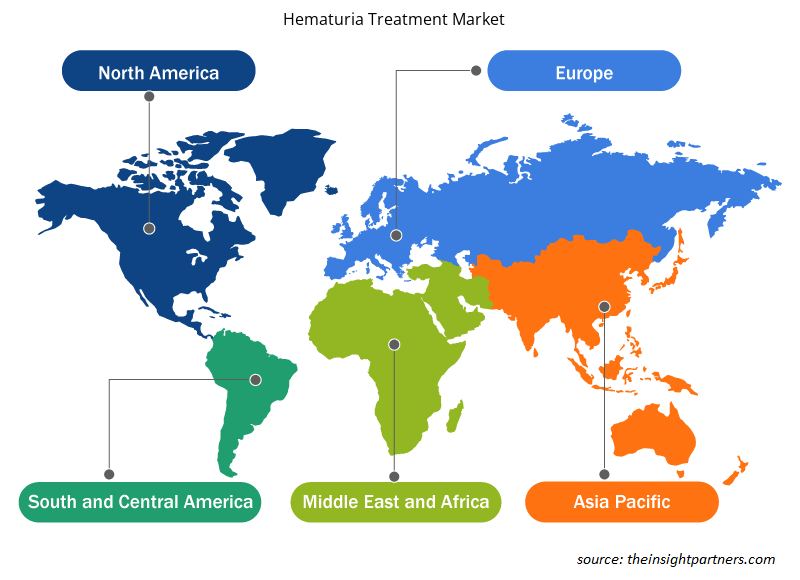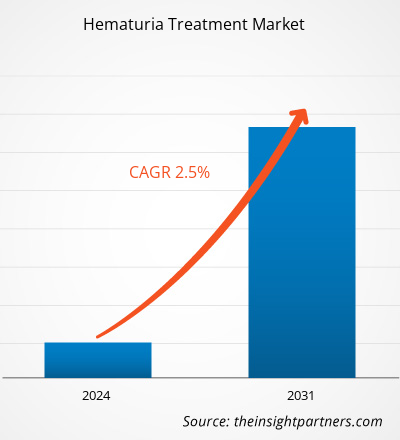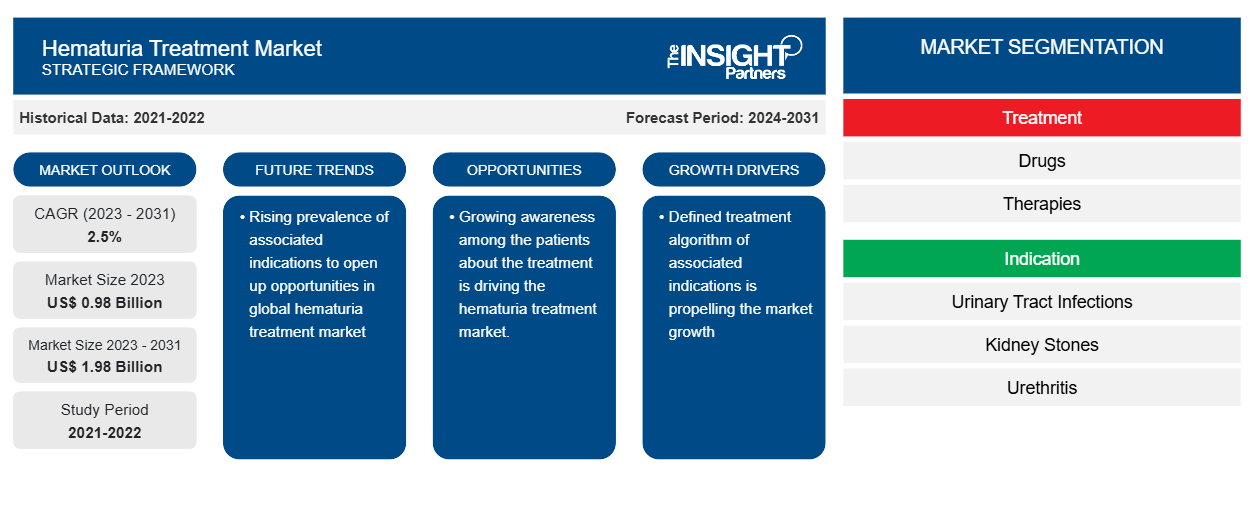Le marché du traitement de l'hématurie devrait atteindre 1,98 milliard USD d'ici 2031, contre 0,98 milliard USD en 2023. Le marché devrait enregistrer un TCAC de 2,5 % au cours de la période 2023-2031. L'augmentation de la préférence pour les thérapies avancées restera probablement une tendance clé du marché.
Analyse du marché du traitement de l'hématurie
Les principaux facteurs qui stimulent la croissance du marché sont la forte prévalence des indications associées à l'hématurie, la sensibilisation croissante aux options de traitement et l'amélioration des dépenses de santé, qui sont des facteurs propulsant le marché du traitement de l'hématurie. En outre, les progrès technologiques dans les dispositifs médicaux et les procédures de diagnostic ont conduit à diverses options pour la gestion des indications associées à l'hématurie, telles que les calculs rénaux, les calculs vésicaux et les infections des voies urinaires, ce qui offrira probablement des opportunités au marché du traitement de l'hématurie dans les années à venir.
Aperçu du marché du traitement de l'hématurie
L'insuffisance rénale chronique (IRC) est une maladie courante et potentiellement mortelle qui touche une plus grande partie de la population mondiale. Il existe différents types d'IRC, tels que les calculs rénaux, la glomérulonéphrite, la maladie rénale polykystique et les infections des voies urinaires. L'IRC est l'une des causes fondamentales de la prévalence de l'hématurie. Par exemple, selon une étude publiée dans le National Center for Biotechnology Information en mai 2019, les infections des voies urinaires (IVU) sont généralement observées en ambulatoire aux États-Unis, survenant principalement chez les femmes de la tranche d'âge de 14 à 24 ans. En outre, la prévalence des infections urinaires chez les femmes de plus de 65 ans est d'environ 20 % par rapport à la population globale, qui est d'environ 11 %. Actuellement, le marché mondial du traitement de l'hématurie bénéficie considérablement de la prévalence croissante des indications associées.
Personnalisez ce rapport en fonction de vos besoins
Vous bénéficierez d'une personnalisation gratuite de n'importe quel rapport, y compris de certaines parties de ce rapport, d'une analyse au niveau des pays, d'un pack de données Excel, ainsi que d'offres et de remises exceptionnelles pour les start-ups et les universités.
-
Obtenez les principales tendances clés du marché de ce rapport.Cet échantillon GRATUIT comprendra une analyse de données, allant des tendances du marché aux estimations et prévisions.
Facteurs moteurs et opportunités du marché du traitement de l'hématurie
Accroître la sensibilisation aux options de traitement et améliorer les dépenses de santé
Les dépenses de santé ont considérablement augmenté en raison de la prévalence croissante des indications chroniques. Les gouvernements de diverses économies investissent considérablement dans l'amélioration des infrastructures de santé. Par exemple, selon les données publiées en décembre 2020 par les Centers for Medicare & Medicaid Services (CMS) des États-Unis, les dépenses nationales de santé (NHE) ont augmenté d'environ 4,6 %, soit 11 582 USD par personne, et ont représenté environ 17,7 % du produit intérieur brut (PIB). En outre, le CMS prévoit que les dépenses de santé aux États-Unis devraient atteindre environ 6 190 milliards USD en avril 2020.
De plus, les patients des économies développées sont de plus en plus informés des traitements possibles et de la possibilité de remboursement du traitement de l’hématurie. L’hématurie fait partie des premières indications de maladies chroniques telles que le cancer du sang, le cancer de la vessie et le cancer du rein. Ces maladies sont couvertes par diverses polices d’assurance maladie qui contribuent à faciliter le traitement des patients et à réduire la charge financière des soins de santé. Ainsi, l’amélioration des dépenses de santé et la sensibilisation des patients au traitement stimulent le marché du traitement de l’hématurie.
Accroître les possibilités de traitements connexes
Le vieillissement de la population, qui est plus susceptible de contracter une hématurie en raison d'une augmentation des calculs rénaux et des infections des voies urinaires, est l'un des principaux moteurs de l'expansion du marché. L'utilisation de technologies de traitement avancées devrait améliorer les soins aux patients. Par exemple, la mise en œuvre de la robotique dans les interventions chirurgicales pour traiter la lithiase urinaire a gagné en popularité ces dernières années. Actuellement, le système chirurgical Vinci, d'Intuitive Surgical Inc., est largement utilisé dans la réalisation d'interventions chirurgicales pour traiter la lithiase urinaire . De même, l'adoption d'interventions endo-urologiques pour les calculs rénaux a considérablement augmenté dans divers pays d'Amérique du Nord, d'Europe et d'Asie. On s'attend également à ce que les progrès dans les indications associées soutiennent le marché mondial du traitement de l'hématurie au cours de la période de prévision.hematuria disease due to an increase in kidney stones and urinary tract infections, is one of the main drivers propelling the market's expansion. The use of advanced treatment technologies is expected to enhance patient care. For instance, the implementation of robotics in surgeries for treating urolithiasis has gained popularity in recent years. Currently, Vinci Surgical System, by Intuitive Surgical Inc., is widely used in performing surgeries to treat endourological interventions for kidney stones has increased significantly across various North American, European, and Asian countries. It is also expected that advancements in associated indications will support the global hematuria treatment market during the forecast period.
Analyse de segmentation du rapport sur le marché du traitement de l'hématurie Treatment Market Report Segmentation Analysis
Les segments clés qui ont contribué à l’élaboration de l’analyse du marché du traitement de l’hématurie sont le type de produit, le type d’indication et l’utilisateur final.hematuria treatment market analysis are product type, indication type, and end user.
- En fonction du traitement, le marché du traitement de l'hématurie est segmenté en médicaments, thérapies et autres. Le segment des médicaments détenait la part de marché la plus importante en 2023.
- En fonction des indications, le marché du traitement de l'hématurie est segmenté par infections des voies urinaires, calculs rénaux, urétrite, cancer du sang, calculs vésicaux, cancer de la prostate, cystite, traumatisme, exercice vigoureux, maladie rénale polykystique, endométriose, menstruation. Le segment des infections des voies urinaires détenait la plus grande part de marché en 2023.
- En fonction de l'utilisateur final, le marché du traitement de l'hématurie est segmenté par hôpitaux, cliniques et centres de soins ambulatoires, entre autres. Le segment des hôpitaux détenait la plus grande part de marché en 2023.
Analyse des parts de marché du traitement de l'hématurie par zone géographique Treatment Market Share Analysis by Geography
La portée géographique du rapport sur le marché du traitement de l’hématurie est principalement divisée en cinq régions : Amérique du Nord, Asie-Pacifique, Europe, Moyen-Orient et Afrique, et Amérique du Sud et centrale.
En Amérique du Nord, les États-Unis constituent le plus grand marché de traitement de l'hématurie. La croissance de ce marché est principalement due à la prévalence croissante des troubles rénaux chroniques (IRC) et au nombre croissant de lancements de produits par des acteurs clés. Par exemple, en 2016, les Centers for Disease Control and Prevention (CDC) ont déclaré qu'environ 0,7 million de personnes étaient traitées pour une insuffisance rénale terminale (IRT) aux États-Unis. La prévalence de l'IRT a plus que doublé entre 1990 et 2016. De plus, l'augmentation de l'incidence de l'hématurie chez les adultes, la montée en puissance de la sensibilisation et les vastes activités de recherche et développement devraient également stimuler la prévalence des traitements de l'hématurie, ce qui offrira à terme une opportunité lucrative pour la croissance du marché.
Aperçu régional du marché du traitement de l'hématurie
Les tendances et facteurs régionaux influençant le marché du traitement de l’hématurie tout au long de la période de prévision ont été expliqués en détail par les analystes d’Insight Partners. Cette section traite également des segments et de la géographie du marché du traitement de l’hématurie en Amérique du Nord, en Europe, en Asie-Pacifique, au Moyen-Orient et en Afrique, ainsi qu’en Amérique du Sud et en Amérique centrale.

- Obtenez les données régionales spécifiques au marché du traitement de l'hématurie
Portée du rapport sur le marché du traitement de l'hématurie
| Attribut de rapport | Détails |
|---|---|
| Taille du marché en 2023 | 0,98 milliard de dollars américains |
| Taille du marché d'ici 2031 | 1,98 milliard de dollars américains |
| Taux de croissance annuel composé mondial (2023-2031) | 2,5% |
| Données historiques | 2021-2022 |
| Période de prévision | 2024-2031 |
| Segments couverts |
Par traitement
|
| Régions et pays couverts |
Amérique du Nord
|
| Leaders du marché et profils d'entreprises clés |
|
Densité des acteurs du marché du traitement de l'hématurie : comprendre son impact sur la dynamique commerciale
Le marché du traitement de l'hématurie connaît une croissance rapide, tirée par la demande croissante des utilisateurs finaux en raison de facteurs tels que l'évolution des préférences des consommateurs, les avancées technologiques et une plus grande sensibilisation aux avantages du produit. À mesure que la demande augmente, les entreprises élargissent leurs offres, innovent pour répondre aux besoins des consommateurs et capitalisent sur les tendances émergentes, ce qui alimente davantage la croissance du marché.
La densité des acteurs du marché fait référence à la répartition des entreprises ou des sociétés opérant sur un marché ou un secteur particulier. Elle indique le nombre de concurrents (acteurs du marché) présents sur un marché donné par rapport à sa taille ou à sa valeur marchande totale.
Les principales entreprises opérant sur le marché du traitement de l'hématurie sont :
- AstraZeneca
- Merck & Co., Inc.
- Société Bristol-Myers Squibb
- Merck & Co., Inc.
- F. HOFFMANN-LA ROCHE LTÉE.
- GlaxoSmithKline plc.
Avis de non-responsabilité : les sociétés répertoriées ci-dessus ne sont pas classées dans un ordre particulier.

- Obtenez un aperçu des principaux acteurs du marché du traitement de l'hématurie
Actualités et développements récents du marché du traitement de l'hématurie
Le marché du traitement de l'hématurie est évalué en collectant des données qualitatives et quantitatives après des recherches primaires et secondaires, qui comprennent d'importantes publications d'entreprise, des données d'association et des bases de données. Quelques-uns des développements du marché du traitement de l'hématurie sont énumérés ci-dessous :
- Farxiga (dapagliflozine) d'AstraZeneca a été approuvé aux États-Unis pour réduire le risque de décès d'origine cardiovasculaire, d'hospitalisation pour insuffisance cardiaque (ICC) et de visites urgentes pour insuffisance cardiaque (IC) chez les adultes atteints d'IC. L'approbation par la Food and Drug Administration (FDA) s'appuie sur les résultats positifs de l'essai de phase III DELIVER.1 Farxiga avait déjà été approuvé aux États-Unis pour les adultes atteints d'IC avec fraction d'éjection réduite (ICrEF). (Source : site Web de la société AstraZeneca, mai 2023)
Rapport sur le marché du traitement de l'hématurie : couverture et livrables
Le rapport « Taille et prévisions du marché du traitement de l’hématurie (2021-2031) » fournit une analyse détaillée du marché couvrant les domaines ci-dessous :
- Taille et prévisions du marché du traitement de l'hématurie aux niveaux mondial, régional et national pour tous les segments de marché clés couverts par le périmètre
- Tendances du marché du traitement de l'hématurie ainsi que dynamique du marché telles que les facteurs moteurs, les contraintes et les opportunités clés
- Analyse détaillée des cinq forces de PEST/Porter et SWOT
- Analyse du marché du traitement de l’hématurie couvrant les principales tendances du marché, le cadre mondial et régional, les principaux acteurs, les réglementations et les développements récents du marché.
- Analyse du paysage industriel et de la concurrence couvrant la concentration du marché, l'analyse de la carte thermique, les principaux acteurs et les développements récents sur le marché du traitement de l'hématurie
- Profils d'entreprise détaillés
- Analyse historique (2 ans), année de base, prévision (7 ans) avec TCAC
- Analyse PEST et SWOT
- Taille du marché Valeur / Volume - Mondial, Régional, Pays
- Industrie et paysage concurrentiel
- Ensemble de données Excel
Rapports récents
Témoignages
Raison d'acheter
- Prise de décision éclairée
- Compréhension de la dynamique du marché
- Analyse concurrentielle
- Connaissances clients
- Prévisions de marché
- Atténuation des risques
- Planification stratégique
- Justification des investissements
- Identification des marchés émergents
- Amélioration des stratégies marketing
- Amélioration de l'efficacité opérationnelle
- Alignement sur les tendances réglementaires























 Obtenez un échantillon gratuit pour - Marché du traitement de l'hématurie
Obtenez un échantillon gratuit pour - Marché du traitement de l'hématurie